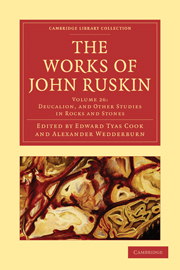Book contents
- Frontmatter
- Contents
- LIST OF ILLUSTRATIONS
- INTRODUCTION TO THIS VOLUME
- I ON THE FORMS OF THE STRATIFIED ALPS OF SAVOY (1863)
- II NOTES ON THE SHAPE AND STRUCTURE OF SOME PARTS OF THE ALPS, WITH REFERENCE TO DENUDATION (1865)
- III ON BANDED AND BRECCIATED CONCRETIONS (1867–1870)
- IV DEUCALION: COLLECTED STUDIES OF THE LAPSE OF WAVES AND LIFE OF STONES (1875–1883)
- V ON THE DISTINCTIONS OF FORM IN SILICA (1884)
- VI CATALOGUES OF MINERALS
- 1 CATALOGUE OF A SERIES OF SPECIMENS IN THE BRITISH MUSEUM (NATURAL HISTORY) ILLUSTRATIVE OF THE MORE COMMON FORMS OF NATIVE SILICA (1884)
- 2 CATALOGUE OF MINERALS IN ST. GEORGE'S MUSEUM, SHEFFIELD (1877–1886)
- 3 CATALOGUE OF FAMILIAR MINERALS IN THE MUSEUM OF KIRKCUDBRIGHT (1884)
- 4 CATALOGUE OF THE COLLECTION OF SILICEOUS MINERALS GIVEN TO AND ARRANGED FOR ST. DAVID'S SCHOOL, REIGATE, BY JOHN RUSKIN (1883)
- 5 CATALOGUE OF MINERALS PRESENTED TO THE CONISTON INSTITUTE (1884)
- 6 CATALOGUE OF MINERALS SHOWN AT EDINBURGH (1884)
- 7 NOTES ON MINOR COLLECTIONS
- VII THE GRAMMAR OF SILICA (not hitherto published)
- APPENDIX: LETTERS, ADDRESSES, AND NOTES
- INDEX
- Plate section
1 - CATALOGUE OF A SERIES OF SPECIMENS IN THE BRITISH MUSEUM (NATURAL HISTORY) ILLUSTRATIVE OF THE MORE COMMON FORMS OF NATIVE SILICA (1884)
Published online by Cambridge University Press: 05 March 2012
- Frontmatter
- Contents
- LIST OF ILLUSTRATIONS
- INTRODUCTION TO THIS VOLUME
- I ON THE FORMS OF THE STRATIFIED ALPS OF SAVOY (1863)
- II NOTES ON THE SHAPE AND STRUCTURE OF SOME PARTS OF THE ALPS, WITH REFERENCE TO DENUDATION (1865)
- III ON BANDED AND BRECCIATED CONCRETIONS (1867–1870)
- IV DEUCALION: COLLECTED STUDIES OF THE LAPSE OF WAVES AND LIFE OF STONES (1875–1883)
- V ON THE DISTINCTIONS OF FORM IN SILICA (1884)
- VI CATALOGUES OF MINERALS
- 1 CATALOGUE OF A SERIES OF SPECIMENS IN THE BRITISH MUSEUM (NATURAL HISTORY) ILLUSTRATIVE OF THE MORE COMMON FORMS OF NATIVE SILICA (1884)
- 2 CATALOGUE OF MINERALS IN ST. GEORGE'S MUSEUM, SHEFFIELD (1877–1886)
- 3 CATALOGUE OF FAMILIAR MINERALS IN THE MUSEUM OF KIRKCUDBRIGHT (1884)
- 4 CATALOGUE OF THE COLLECTION OF SILICEOUS MINERALS GIVEN TO AND ARRANGED FOR ST. DAVID'S SCHOOL, REIGATE, BY JOHN RUSKIN (1883)
- 5 CATALOGUE OF MINERALS PRESENTED TO THE CONISTON INSTITUTE (1884)
- 6 CATALOGUE OF MINERALS SHOWN AT EDINBURGH (1884)
- 7 NOTES ON MINOR COLLECTIONS
- VII THE GRAMMAR OF SILICA (not hitherto published)
- APPENDIX: LETTERS, ADDRESSES, AND NOTES
- INDEX
- Plate section
Summary
PREFACE
This series of specimens has been selected to illustrate the more frequent varieties of Native Silica. One of these, quartz, is the most common of minerals; it is almost the only component of most gravels, sands, and sandstones, while it enters largely into the composition of many of the metamorphic schists and crystalline rocks: others, as flint and jasper, though not so plentiful, are still important constituents of the earth's crust; while chalcedony, the principal substance of agates, from early periods has been an important material in the arts. These varieties are in most works on mineralogy treated as accidental conditions of one and the same substance. But they are in this carefully chosen series exhibited in their essential distinctions, and their gradated phases of connecting state; and they may be studied in these generally occurring forms with the greater facility, because all those siliceous minerals have been excluded which appear to have been produced by narrowly local circumstances. Thus chalcedony involved in bitumen found in Auvergne, and nearly all the forms of opal, including hyalite and cacholong, must be looked for in their proper places in the great gallery; few minerals being shown in this selected series but those which, though here seen in their finest conditions, are in their less striking forms of frequent occurrence, and of extreme importance in the structure and economy of the world.
- Type
- Chapter
- Information
- The Works of John Ruskin , pp. 395 - 414Publisher: Cambridge University PressPrint publication year: 2010First published in: 1906



